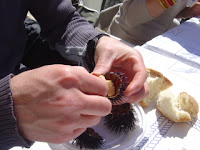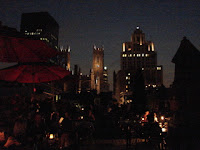We prepare dinner for new friends who are leaving their summer idyll in Vermont. They are like we are when we leave Italy, packing up, saying good-bye, feeling the bittersweet departure coupled with the plans to return. The night cooperates. There is warm evening weather, and the turkeys living in our meadow trot our their new brood. We tour the gardens and the dusk hides a multitude of weedy sins. We play at summer house with cocktails on the terrace with a fresh cow's milk-sheep's milk cheese from northern Italy paired with rice crackers, olives and cornichons.
Dinner is also on the terrace with the chandelier lighted and the torches blazing. When darkness comes so does a chill in the air and we light a fire in our make-shift fire pit which radiates warmth. We sit at table to a favorite wine, coppa with fresh figs, the local bufala mozzarella with our own tomatoes colored both yellow and red, and a shrimp salad made with lime and herbs. The air smells of fresh mown hay. We tell stories, look at pictures, and plan future trips. The full moon rises, broad and orange, so obligingly. A fat spider slides down a thread from her web infront of the window. Once the moon is quite high, a dessert of peach tart is taken inside, upstairs in the livingroom. The meal is finished with last year's nocino alongside the walnut liquer from the southern reaches of Puglia in Italy's heel that inspired out own.
After our guests leave, we leave the dishes in the sink, and lie down on a bed of pillows under the sky. We watch the moon, and contemplate our empty terrace, the candles burning low, remembering long ago dinners under our wildly growing grapes. We imagine future late night card games at the dinner table accompanied by a pot of tea or a tot of whiskey. We remember and catolog our best meals of the summer. This was one of them.
Lime Herb Shrimp Salad for 4
Inspired by: 1) the desire for a cold summer shrimp salad, 2) a plentitude of herbs and the memory of a tabouleh dish at the Cafe Opaline in Manhatten, 3) a memory of a salad loaded with scallion in Belfast, Ireland prepared by a chef who'd spent time traveling in Malaysia.
4 dozen medium shrimp, peeled and deveined
12 scallions, green parts and all
a handful of mint leaves
a handful of cilantro leaves
half a handful of parsley
a walnut-sized piece of fresh ginger, peeled and grated
a clove of garlic(optional), peeled and grated liked the ginger
juice of 2 limes
extra virgin olive oil
salt & pepper
Boil shrimp until just cooked in well-salted water. Drain and chill in cold running water briefly. Drain well again and put into a large tossing bowl. Season liberally with salt and pepper. Add the lime juice, grated ginger and garlic, and a little olive oil. Toss. Taste for seasoning. Add more salt if necessary. Finely chop the scallion, mint, parsley, and cilantro. Toss the herbs well with the shrimp, and serve.









































